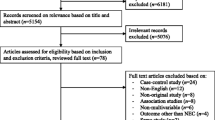Abstract
Clinical audits must be based on good data and what is being reported must be clearly defined. Severity-of-illness scores (SOI) have been developed for newborns and neonates; neonatal surgical case reviews have to be stratified in this manner in the future. This assessment addresses risk to life (predicted mortality) estimated at the point immediately before surgical treatment. General neonatal cases are divided into group A: primary problem medical, complications require surgery; and group B: major malformations that require surgery. Risk categories are established using NTISS scores for group A patients. A new scoring method still to be validated is used in group B. The applicability of the suggested methods are tested using 50 patients with necrotising enterocolitis (group A) and 50 with oesophageal atresia/tracheo-oesophageal fistula (group B). This, a first attempt at stratifying surgical neonatal cases in this manner, illustrates the importance of refining clinical audits in this way. The further development of neonatal SOI risk scores and the utilisation of such tools in risk assessment in surgical patients is awaited.
Similar content being viewed by others
References
Frater A, Costain D (1992) Editorial — Any better? Outcome measures in medical audit. Br Med J 304: 519–520
International Neonatal Network to study the Outcome of Care for very low birthweight infants (1993) the CRIB (Clinical Risk Index for Babies) study. Supported by: Medical Research Council, Scottish Office, Action Research, Wellcome Trust
Pollack MM, Yeh TS, Ruttimann UE, et al (1984) Evaluation of pediatric intensive care. Crit Care Med 12: 376–383
Keene AR, Cullen DJ (1983) Therapeutic Intervention Scoring System: update 1983. Crit Care Med 11: 1–3
Georgrieff MK, Mills MM, Bhatt P (1989) Validation of two scoring systems which assess the degree of physiologic instability in critically ill newborn infants. Crit Care Med 17: 17–21
Pollack MM, Ruttimann UE, Getson PR, et al (1987) Accurate predictions of the outcome of pediatric intensive care. A new quantitative method. N Engl J Med 316: 134–139
Tepas JJ, Mollitt DL, Talbert JL, et al (1987) The pediatric trauma score as a predictor of injury severity in the injured child. J Pediatr Surg 22: 14–18
Ramenofsky ML, Ramenofsky MB, Turkovich GJ, et al (1988) The predictive validity of the pediatric trauma score. J Trauma 28: 1038–1041
Apgar V (1953) A proposal for a new method of evaluation of the newborn infant. Anesth Analg 32: 260
Teasdale G, Jennet B (1974) Assessment of coma and impaired consciousness. A practical scale. Lancet II: 81–84
Waterston DJ, Bonham-Carter RE, Aberdeen E (1962) Oesophageal atresia. Tracheo-oesophageal fistula. Lancet I: 819–822
Phibbs CS, Williams RL, Phibbs RH (1981) Newborn risk factors and cost of neonatal intensive care. Pediatrics 68: 313–321
Gray JE, Richardson DK, McCormick MC, et al (1992) Neonatal Therapeutic Intervention Scoring System: a therapy-based severity-of-illness index. Pediatrics 90: 561–567
Knaus WA, Zimmermann JE, Wagner DP, et al (1981) APACHE —acute physiology and chronic health evaluation. A physiologic based classification system. Crit Care Med 9: 591–597
Goddard JM (1992) Pediatric risk of mortality scoring overestimates severity of illness in infants. Crit Care Med 20: 1662–1665
Richardson DK, Gray JE, McCormick MC, et al (1993) Score for neonatal acute physiology: a physiologic severity index for neonatal intensive care. Pediatrics 91: 617–623
Cullen DJ, Civetta JM, Briggs BA (1974) Therapeutic intervention Scoring System: a method for quantitative comparisons of patient care. Crit Care Med 2: 57–64
Yeh TS, Pollack MM, Holbrook PR, et al (1982) Assessment of pediatric intensive care — application of the Therapeutic Intervention Scoring System. Crit Care Med 10: 497–500
Ruttimann UE, Albert A, Pollack MM, et al (1986) Dynamic assessment of severity of illness in pediatric intensive care. Crit Care Med 14: 215–221
Richardson DK, Gray JE, McCormick MC, et al (1992) Birth-weight and illness severity: independent predictors of NICU mortality (abstract). Pediatr Res 31: 258 A
Author information
Authors and Affiliations
Rights and permissions
About this article
Cite this article
Davies, M.R.Q. The need for a universal method of quantifying severity of illness to allow accurate analysis of the results of treatment in neonatal surgical cases. Pediatr Surg Int 10, 305–308 (1995). https://doi.org/10.1007/BF00182208
Accepted:
Issue Date:
DOI: https://doi.org/10.1007/BF00182208




